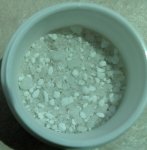I was in the process of shocking, using the TF-100 test kit, and started an overnight FC loss test with an initial evening reading of 15ppm using FAS/DPD. The next morning bright and early I filled up my separate sample bottle, did the test, and the FC was at 13ppm. I dumped out the tested water, but then thought I should also test the CC, so I re-did the FC test (with the same water sample from my sample bottle) and got a reading of 15ppm. Being suspicious, I did the test a 3rd time and got a reading of 16ppm. Each time after adding the 0870 powder my solution was dark pink so I believe the tests were done properly.
I noticed the R-0870 DPD Powder I have has a varied texture to it (see pic). There is very fine particles and various sizes of larger particles. Seems this would make it difficult to get a predictable mix of those when taking a scoop. Is this normal? Could this be the cause of the inconsistent tests? If not, any other ideas? Thx.
[attachment=0:2q0rfqcu]R-0870 DPD Powder-cropped75.jpg[/attachment:2q0rfqcu]
I noticed the R-0870 DPD Powder I have has a varied texture to it (see pic). There is very fine particles and various sizes of larger particles. Seems this would make it difficult to get a predictable mix of those when taking a scoop. Is this normal? Could this be the cause of the inconsistent tests? If not, any other ideas? Thx.
[attachment=0:2q0rfqcu]R-0870 DPD Powder-cropped75.jpg[/attachment:2q0rfqcu]


